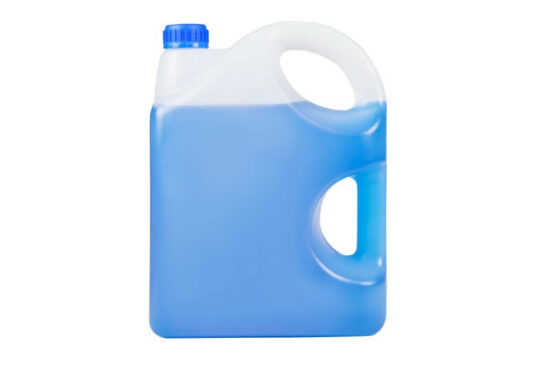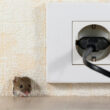Killing groundhogs with antifreeze is a method that is talked about quite a lot.
But does it actually work?
This guide dives into how viable it is to kill groundhogs with antifreeze, and gives you some tips if you want to try it yourself.
Table of Contents
Will Antifreeze Kill Groundhogs?
Antifreeze is a powerful substance that’s predominantly used in vehicles. If you live in an area that experiences frequent cold snaps during the winter, you’re probably familiar with the stuff! Available at most hardware stores and auto shops, it’s easy to source and relatively affordable.
The purpose of antifreeze is to lower the freezing point of water. It comes in a simple liquid form and mixes with water to make it harder for ice crystals to form. It doesn’t prevent freezing entirely, despite what its name might lead you to believe.
But it does make water less likely to freeze in standard freezing temperatures. It does this through the use of many chemicals. One chemical that has proven helpful in pest control circles is ethylene glycol.
Ethylene glycol is a unique chemical found in many products. Not only is it in antifreeze, but it’s also in brake fluid, paints, solvents, and more.
This chemical is also a potent central nervous depressant. It has toxic metabolites that will shut down the central nervous system. The toxin is similar to the effects of other chemical-based pesticides, causing the entire body to shut down.
That means if a groundhog ingests antifreeze, their nervous system will be under attack. Eventually, organs shut down and the heart stops beating.
Antifreeze will kill groundhogs. In fact, its chemical ingredients are powerful enough to kill many pests. It’s also dangerous for humans, so you must exercise caution if using it as a way to eradicate groundhogs.
Is It Effective?
Killing groundhogs with antifreeze is moderately effective. It’s not a surefire way to kill groundhogs, but there’s a decent chance it will do the job.
The chemicals in antifreeze are no joke. They severely damage the nervous system, and the effects of the toxins usually appear in as little as an hour! Death is a slow process, but it’s almost guaranteed if the groundhog drinks it.
Therein lies the biggest issue with antifreeze. Like any other poisoning technique, its success relies on whether the animal will consume the stuff!
Fortunately, antifreeze has something that other chemicals don’t: A palatable taste! Believe it or not, antifreeze has a sweet flavor and a surprisingly attractive aroma. Some compare it to candy or maple syrup.
The smell is pretty deceiving, given its harmful constituents. However, it can be helpful when used practically. Here’s a quick tip: If you smell the sweet aroma when driving, it likely means you have a refrigerant leak somewhere!
That means the smell and taste can work in your favor for killing groundhogs with antifreeze. Because it’s naturally attractive, groundhogs are more interested in giving it a try than other poisons. With other chemicals, you might have to mask it with peanut butter or other food products.
But that’s not the case with antifreeze. Groundhogs don’t know any better and often drink it willingly! While there are no guarantees, the sweet taste does improve efficiency slightly.
Why It’s Important To Check Local Law
You might be tempted to grab a jug of antifreeze and start planning your attack against those pesky groundhogs. But before you do, pump the brakes and do a little research.
In some states throughout the country, poisoning groundhogs is illegal. Laws can vary from one state to the next. There’s no wide-reaching federal law surrounding this topic.
Contact local officials for clarity. It’s also important to look into specific poisoning laws. Some jurisdictions might have strict regulations about what you can place into the soil for fear of groundwater contamination.
If you live in a state where poisoning groundhogs or using toxic chemicals on your property is illegal, you’ll need to try other extermination methods. Killing groundhogs with antifreeze in these areas could lead to steep fines and possible jail time.
How To Start Killing Groundhogs With Antifreeze
So, you’ve checked local laws and you’re good to go. What now?
Killing groundhogs with antifreeze is a pretty straightforward process. Thanks to its sweet taste and smell, half the work is already done for you. But because it has a thin liquid consistency, you must work a little harder to prepare your poison trap for the best chances of success.
Follow these steps to kill groundhogs with antifreeze.
1. Prepare A Plastic Bottle
The first step when killing groundhogs with antifreeze is preparing a plastic bottle. Why? You can’t simply dump the antifreeze nearby and hope for the best.
Antifreeze has a very thin consistency. Pouring it directly onto the ground will only cause it to sink into the soil. Groundhogs won’t even attempt to drink it at that point. They may still smell that sweetness, but most poisons are gone.
A plastic bottle will serve as the delivery receptacle. You can use any old bottle you have lying around, but a two-liter soda bottle is best. An empty two-liter bottle is a perfect size for proper placement (more on that later).
After cleaning the bottle out, grab a sharp knife or some scissors. Cut a relatively small hole on the side of the bottle. Make sure there are a couple of inches of space between the bottom of the bottle and the hole.
The goal here is to create something akin to a birdhouse. The bottle needs to hold a good amount of antifreeze, but it should have an easily accessible opening that the groundhog can use to drink the fluid.
The hole doesn’t have to be enormous, but it should have a big enough diameter for the groundhog to stick its head inside.
2. Fill The Bottle With Antifreeze
Once you have the bottle ready to go, fill it with antifreeze. Make sure to grab one that contains that all-important chemical: ethylene glycol.
Most antifreeze products you see lining store shelves will contain ethylene glycol, but it’s a good idea to double-check for good measure.
Carefully open the antifreeze bottle and pour some into the hole of the bottle you just prepared. Bring the antifreeze level close to the opening you cut. Don’t fill it so much that the antifreeze splashes out.
But fill it enough so groundhogs can lap it up without climbing into the bottle to access it.
3. Place The Bottle Strategically
You now have the trap that you’ll be using to kill groundhogs! Now, your next task is to place it strategically.
Groundhogs have a reasonably good sense of smell, but you want to keep it close enough to their signature tunnels to attract them.
The best place? Just outside of the tunnel entrances!
Keep it about a foot or so away from the entrance. That’s close enough to capture their attention when exiting the hole. However, it won’t be in the way, forcing the animal to accidentally tip the trap over and spill the antifreeze.
Should You Use This Method?
You can certainly give this method a try. It has the potential to be effective. Antifreeze is poisonous enough to the animal to cause death if they drink it.
But should you try it?
Killing groundhogs with antifreeze is not something that we recommend. There are far better alternatives out there.
Despite its potential, there are no guarantees. Too many factors come into play. If a groundhog doesn’t drink enough of it, the poison might not have the intended effect.
It’s just not effective or foolproof enough to be your go-to.
Plus, there’s always the potential to kill other animals. You’re essentially leaving a bottle of sweet-smelling toxic chemicals for any animal to drink up. There’s a good chance you’ll kill innocent animals as they pass by, which could get you into trouble!
Instead of killing groundhogs with antifreeze, you can turn to a pest control expert if you really want to deal with these animals on your property. Trapping is more reliable, more humane, and has a greater chance of success.
Conclusion
Killing groundhogs with antifreeze is possible, but it’s not something we think you should do. There are more effective and humane methods at your disposal.
If you have questions about this method and want some feedback, send us a message. We’re more than happy to chime in!


